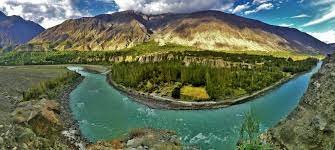ByMuneer Hussain
Gilgit Baltistan lies amidst of towering peaks of the Karakorum and Himalyan range situated at the extreme north of Pakistan.It stands as a testament to the beauty and cultural diversity of Pakistan’s northern part.Gilgit Baltistan is a region of magnificent mountains,lustrous glaciers and diverse ecosystem.The greatest water sources of this region are glaciers and snowmelt water, with that natural springs,rainfall also contributes to more extent.
Gilgit Baltistan is home to numerous glaciers,these glaciers act as natural reservoirs, storing water in the form of ice and releasing it gradually as meltwater during the summer.The region receives significant snowfall during the winter, especially in higher elevations. As temperatures rise in the spring and summer, the snowpack melts, contributing to river flow.
Glacial and snow meltwater running through the mountains and enter the rivers and streams providing water for irrigation,drinking and hydropower generation.Due to climate change, global warming become another worst issue as it depletes capacity of these natural resources.The indigenous peoples suffer from drought,flooding and scarcity of drinking water.
The people of Gilgit-Baltistan are committed to preserving their traditions and environment for future generations. Community-led conservation initiatives, sustainable water management and efforts to promote eco-friendly development are all part of the region’s ongoing commitment to cope with this issue. So the indigenous peoples start sustainable management of water resources.
They make qanat and karez system,in which underground aqueducts and tunnel tap into ground water source in mountainous regions and transport it to arid land for drinking and agricultural use.With the help of gravity,it minimizes the waterloss and ensures equal distribution of water in an agricultural land.
In some areas of GB, glacial grafting is practiced inorder to increase glaciers. In this technique according to the locals there are male glacier and female glaciers.They cut a piece from both genders and their grafting is done by mixing both and buried them so it gives rise to a new glacier here.Glacial grafting is a relatively new concept and has been proposed as a potential strategy to mitigate the impacts of climate change on glaciers and downstream water resources.
To maximize water use efficiency and decrease soil erosion,the people practiced terraced farming.Terraces are built on steep slope for plantation or crops cultivation.This method helps to slowdown runoff water speed by increase infiltration.Additionally, terraces reduce soil erosion and increase the water retention capacity of the land.
Another common practice of water conservation is rainwater harvesting,they store waters by making “khals”.Farmers in Gilgit-Baltistan apply various traditional irrigation techniques to maximize water efficiency. Methods such as furrow irrigation, drip irrigation, and sprinkler irrigation are used.It transfers water directly to the root zone of crops, minimizing waterloss by evaporation.
These practices not only conserve water but also maximize crop yields,so these practices contribute to enhance the livelihood of the people of this region.Another practice of water conservation in Gilgit Baltistan is the construction of check dams along streams and rivers to capture and store rain water during monsoons.
These structures not only help in flood control but also serve as water harvesting facilities,storing water for irrigation as well as domestic use, during dry season.Water management in Gilgit-Baltistan is often organized at the community level, with traditional systems of water distribution. Community-managed water committees, known as “abaadgaran”oversee distribution of water resources among farmers, ensuring that each member gets water according to their land.
This will enhance cooperation,solidarity and brotherhood among peoples.Overall, these indigenous practices of water conservation in Gilgit-Baltistan demonstrate the inventiveness, resilience, and cozy connection of local communities with their natural environment. In this era of water scarcity and climate change challenges from which the whole world is suffering.
These traditional water management practices play crucial role in the sustainable management and resilience of the region’s ecosystems and livelihood. “We need the planet earth,the planet doesn’t need us”.


